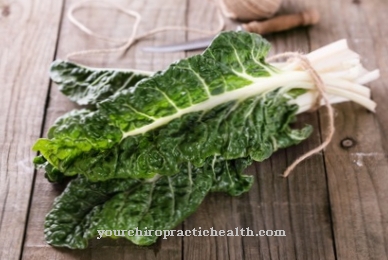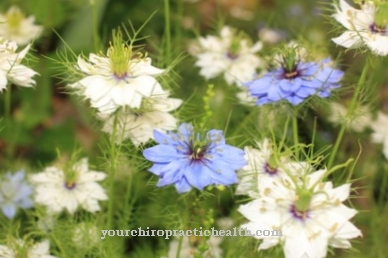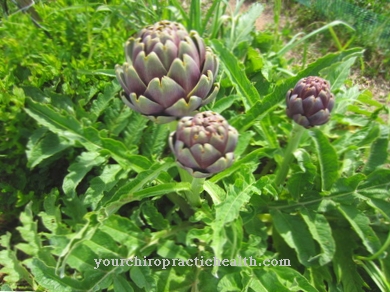Lady's mantle (Alchemilla) belongs to the rose family and is native to Africa, Asia and Europe. Lady's mantle is very well known as a medicinal plant, especially in gynecology.
Occurrence & cultivation of lady's mantle

Lady's mantle is a herbaceous plant with small, petalless flowers. The leaves are shaped like a protective coat, another specialty is that in the morning you will find a drop of a plant distillate in the leaf calyx that comes from the pores on the leaf edge. In addition, the flowers of the woman's mantle can form seeds without male fertilization. The roots of the plant are heavily woody, the leaves are shaggy and hairy and have five to nine lobes.
The flowers are pale yellow and very rich in nectar, which also attracts many bees. There are around 1000 different species, with around 300 native to Europe. The name Alchemilla can be derived from the term alchemy, as the alchemists in the Middle Ages collected the dew of the plant to make the philosopher's stone. Lady's mantle is also often referred to as thunderstorm grass, as it was previously believed that a wreath made from the plant could protect against a thunderstorm.
The real name of the plant is very different. So in some regions it is called Women's helpcalled, others call it Röcklior Frauenhäubl. In the Middle Ages the plant was also known as Ladybirdor Mary's coatbecause the shape of its leaves was reminiscent of the mantle of statues of the Virgin Mary. Lady's mantle likes to grow in meadows or in sparse forests and is about 50cm tall.
Effect & application
Dioscurides used the plant mainly as a wound herb to stop bleeding, as lady's mantle has a very strong astringent effect. Women who suffer from heavy bleeding during menstruation can also benefit from this effect. In addition, the plant also helps regulate the cycle.
Furthermore, lady's mantle also has a birth-promoting or birth-facilitating effect and can strengthen the pelvic muscles. In folk medicine, the plant was therefore used as a cure about six weeks before birth. After giving birth, lady's mantle is also suitable for cleaning the uterus and healing any injuries. In the case of thyroid diseases and diabetes, lady's mantle stimulates the activity of the glands, and the plant also helps with hardening of the arteries, anemia, rheumatism and gout.
It is also helpful for endometriosis and fibroids. Herbalists used to use lady's mantle to treat liver problems or diarrhea, gastrointestinal disorders and sleep disorders. The plant is also used for eczema, rashes, cuts or insect bites. As a gargle, a women's mantle tea helps with sore throats, bleeding gums and mouth ulcers.
The herb is also often used in the kitchen. Lady's mantle has a peppery and piquant taste and is therefore often used for spreads. To do this, mix the crushed leaves with cream cheese, salt and pepper. Lady's mantle contains tannins that inhibit the growth of bacteria and help prevent cancer. Other ingredients are vitamins A and C and flavonoids, which reduce muscle tension in the arteries.
Importance for health, treatment & prevention
A women's mantle tea can be made very easily yourself. The leaves of the plant are best collected before the flowering period in April or May. Then they are cut into small pieces and dried on a cloth in a well-ventilated room. The dried herb is then boiled in water, then left to steep for five minutes and then poured off the tea.
For a tea mixture against menstrual cramps, mix two parts of lady's mantle herb, two parts of marigold flowers, two parts of nettle leaves and one part of chamomile flowers. Two teaspoons are then poured over 1/4 liter of boiling water. Let it steep for ten minutes, strain and drink about three times a day. To make a tincture, you need 8g of flowers and leaves, 40g of lady's mantle root and around 150g of 50 to 60 percent alcohol.
The root is dug up, washed and scraped, and then cut into small slices. Also divide the flowers and leaves into small pieces, then put everything in a glass and add the alcohol so that the roots are well covered. Now the tincture has to ripen for a moon, then it is filtered and bottled. A woman's coat tincture can help with irregular menstrual periods and is also used to treat menstrual pain or menopausal symptoms. It also helps with breast tenderness, depressive moods, migraines, spotting and sleep disorders, whereby about three to four drops should be taken daily.
Anyone suffering from vaginal irritation can use an ointment made from lady's mantle for external treatment. An oil extract from yarrow, lady's mantle and angelica root can also prevent milk congestion and tighten the breast. Envelopes made from fresh lady's mantle help to stop bleeding and are also used for rapid wound healing. The decoction of the plant is also suitable for external use, which can be helpful for superficial infections or inflammations.
Lady's mantle is also offered in the form of tablets or dragees, and the extracts of the plant can also be found in lozenges, mouthwash or in various ointments. It should be noted that a daily dose of 5 to 10g should not be exceeded. In the event of an overdose, the tannins contained in the plant can irritate the mucous membranes and lead to nausea.




























